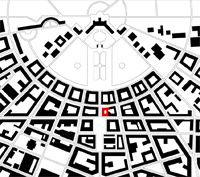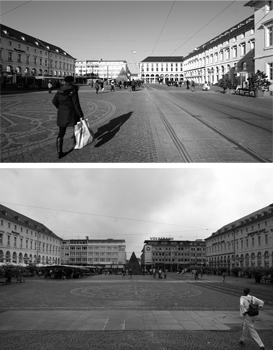You are in: Home page > Magazine > Bauen im Bestand
Bauen im Bestand
Kaiserkarree in Karlsruhe

Arno Lederer
Let’s try to imagine having to restore a baroque picture, perhaps a painting by Canaletto, representing a beautiful city. The image would have a flaw, not immediately obvious, but there nonetheless; where one or two houses used to be clearly visible, now a stain would occupy the surface of the canvas. We would have three possibilities to intervene: 1. We could try a reconstruction using old drawings, which would allow us to return the work of art to its former glory. 2. We could paint it in a totally new modern form that entirely covers the stain - not concealing a personal way of painting. So even a layperson would understand on first sight that this is an addition done in the 21st century. 3. We could add the missing buildings in such a way that a layperson would not immediately notice the restoration. Only after taking a second, closer look, the addition would be realised. Perhaps an expert would easily notice our work, because his or her skilled eye would be able to see it.
Now, we would like to apply this simplified model for further discussion to the city and its buildings. For centuries it wasn’t a blemish to complete voids of a city by using the existing grammar. However it became a shame or embarrassment in consequence of the “ethical mace”, with which the modern movement was threatening the architects. Those who orientated themselves on history were not part of the exclusive circle of the progressive avant-garde architects. And this progress was the “Golden Calf”, from which - during the last century - everyone tried to take advantage of.
We ourselves, who learned that shutters and sloping roofs were embarrassing choices, that for building a house no more than one or two materials should be used, or that the identity of each new project should be unequivocally distinguished from its already existing context, suddenly find ourselves faced by a situation, that lets us understand that this presumed freedom, that found expression in the conquests of technique, was essentially based on a very limited story.
Just like after many years a door opens into a house, it is only a few years that we’ve been aware of how rich architecture actually is. All it takes is to understand, that changes in architecture should not be read along as an upcoming vertical axis towards a better and better building culture, but as a time-independent coexistence of different spatial models. Just as in literature, we cannot state that Goethe is more progressive than Montaigne, or Sartre is more progressive than Strindberg, so too the architecture of successive centuries can neither be defined as better nor as more progressive than those of an earlier epoch. This however doesn’t mean, that modern architecture is worse than architecture of other epochs. But now the time has come to free ourselves from the missionary zeal that has imposed “the Modern” as the right rule and one that is better than all other possible worlds.
Some years ago, after winning a competition for the construction of a commercial building, we received a heap of criticism. A petition was drawn up by a group of citizens, guided by local architect colleagues. What was the occasion?
Karlsruhe is one of the most famous examples of an idealistic Baroque city. There is no book on urban architecture, that does not liken the plan of this city to the shape of a fan. No less famous is the expansion of the city by the Neo-Classical architect Friedrich Weinbrenner (1766-1826). He developed an exemplary city plan, placing the main public buildings, such as the church and the town hall, in a prominent position and designing them in a special form according to their importance for the city. As for the development of the dwellings, Weinbrenner also planned models of private houses, classified on the basis of budget and social position. Hence he developed different types of houses that could feature slight variations produced by the decoration of the façades. Today, Weinbrenner’s plan would be considered as a well-defined masterplan, in which the façades are relatively fixed, but where the architects can still exercise a certain freedom of expression.
After the war, when the city was rebuilt, the market square was reconstructed on three sides, following Weinbrenner’s style. Instead, the north side of the square was rebuilt in a modernist style typical of post-war Germany. At a certain point, one of these buildings, whose interior had been completely rebuilt in the meantime, needed renovating. But why was it necessary to keep the original modernist façade when there was no longer a correspondence with the floor plan? Wouldn’t this be a contradiction in terms? In addition to this, the client demanded higher storeys, so that the existing openings of the windows in the façade would no longer correspond to the modified height between floors.
We wondered whether in regard of the restoration problem mentioned at the beginning, if in this case it wasn’t much more important to respect the overall layout of the city, with its famous market square, rather than the single building as a document of the post-war period. “First the city, then the house”, this is unquestionably a guiding principle of our work. Why in this case should the principles of Weinbrenner’s masterplan not be followed? Its parameters with ground floor arcades, a façade in brick with the windows of the same size as those of the adjacent buildings, the same proportions and the same cityscape of roofs, or the same handling of the “angular conflict” that could be identified in the plans of the old buildings?
This attitude is probably what infuriated the architects and architectural historians. They condemned this approach as if it were a betrayal of the modern architecture. They didn’t want to understand, that it is also possible to continue building a city starting from its pre-existing architecture. In the interim the house was built and everyone calmed down. “Why did...” many asked us, “your project come in for such heavy criticism?” The city and its inhabitants are satisfied. When our new building became the subject of a conference on the city’s architecture, and when Nathalie de Vries (MVRDV) was asked which period it was built in ‒ whether it was new, thirty or forty years old, or even built much earlier, she had trouble guessing.
And this riddle for us was an indication of success...
Arno Lederer (Stuttgart 1947), architect, studied in Stuttgart and Vienna. He has been a professor at the University of Karlsruhe (1990-2005) and is currently teaching in Stuttgart, where since 2005 he is directing the Institute for Public Building and Design. Since 2007 he has been a member of the foundation for architectural culture in Potsdam.
















